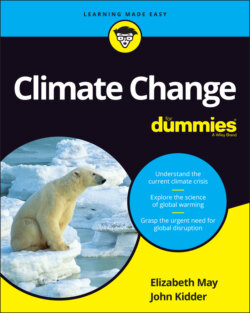Читать книгу Climate Change For Dummies - Elizabeth May - Страница 51
Checking Out the Other GHGs
ОглавлениеCarbon dioxide may get all the press, but 23 other GHGs (in five main groups) also heat things up. Although they’re present in much smaller amounts, these gases are actually far more potent, molecule for molecule, in terms of greenhouse effect. You might think of them as carbon dioxide on steroids. Table 2-1 shows you the power of some of these gases compared to carbon dioxide as the reference starting point with a global warming potential of 1.
TABLE 2-1 Global Warming Potential of GHGs
| GHG | Global Warming Potential Over Time | |
|---|---|---|
| 20 years | 100 years | |
| Carbon dioxide (CO2) | 1 | 1 |
| Methane (CH4) | 56 | 21 |
| Nitrous oxide (N2O) | 280 | 310 |
| Hydrofluorocarbons (HFC) Group of 13 gases | 3,327 | 2,531 |
| Perfluorocarbons (PFC) Group of 7 gases | 5,186 | 7,614 |
| Sulfur Hexafluoride (SF6) | 16,300 | 23,900 |
Source: United Nations Framework Convention on Climate Change, GHG Data, Global Warming Potentials, http://unfccc.int/ghg_data/items/3825.php
Because so many different types of GHG exist, people usually either talk about only carbon dioxide (because so much more of it exists than the others) or GHGs in terms of carbon dioxide equivalents — how small an amount of the gas you’d have to put into the atmosphere to have the same warming impact as the current level of carbon dioxide. Referring to all GHGs with this measurement makes assessing and measuring them that much easier. So, when we say “greenhouse gas” in this book, you can actually think of it as carbon dioxide equivalent emissions. No calculator needed.
Measuring in carbon equivalents means, for example, that 1 unit of methane equals 21 units of carbon. In other words, 1 metric ton of methane is just as bad as 21 metric tons of carbon dioxide. Thus, methane is 21 carbon dioxide equivalents, or 21 metric tons of carbon dioxide.
